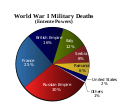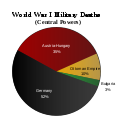- Military attachés and war correspondents in the First World War
-
Military attachés and war correspondents in the First World War were historians creating first-hand accounts of a multi-national, multi-continent, multi-ocean military conflict. In this multi-year series of military engagements across a worldwide landscape of theaters of battle, the military taxonomy of war became increasingly complex.
The First World War was the first modern mediated war in the sense that warfare becomes conflicts and controversies between parties who exchange information and arguments indirectly by the mass media. The discourse in mediated conflicts is influenced by its public character. By forwarding information and arguments to the media, conflict parties attempt to gain support from their constituencies and persuade their opponents.[1]
Contents
Overview
Main article: First World War Pie chart showing deaths by alliance and military/civilian. Most of the civilian deaths were due to war related famine.
Pie chart showing deaths by alliance and military/civilian. Most of the civilian deaths were due to war related famine.
The multi-national military attachés and observers who took part in the First World War were expressly engaged in collecting data and analyzing the interplay between tactics, strategy, and technical advances in weapons and machines of modern warfare. Military theorist Carl von Clausewitz stressed the significance of grasping the fundamentals of any situation in the "blink of an eye" (coup d'œil). In a military context, the astute tactician can immediately grasp a range of implications and can begin to anticipate plausible and appropriate courses of action,[2] but World War I resisted the conventional pre-war taxonomies and paradigms.
Military and civilian observers from every major power closely followed the course of the war. Most were able to report on events from a perspective somewhat like what is now termed "embedded" positions within the land and naval forces of both sides. These military attachés, naval attachés and other observers prepared voluminous first-hand accounts of the war and analytical papers. In-depth observer narratives of the war and more narrowly-focused professional journal articles were written soon after the war; and these post-war reports conclusively illustrated the battlefield destructiveness of this conflict.
The functions of a military attaché are illustrated by the American military attachés in Japan during the war years. A series of military officers had been assigned to the American diplomatic mission in Tokyo since 1901 when the US and Japan were co-operating closely in response to the Boxer Rebellion in China. The military attaché advised the United States Ambassador to Japan on military matters, acted as a liaison between US Army and the Imperial General Headquarters, and gathered and disseminated intelligence. The military attaché's office in Tokyo usually had two assistants and a number of "language officers" who were assigned specifically to learn Japanese whilst attached to Japanese Imperial Army regiments as observers. These "language officers" translated training and technical manuals and reported on conditions in Japanese military units.[3]
Selected military attachés serving with Entente powers
 Pie chart showing military deaths of the Entente Powers.
Pie chart showing military deaths of the Entente Powers.
Russia
- Nakajima Masatake, Japan (1915).[4]
- Mitsumasa Yonai, Japan (1915).[5]
France
- James Collins, US (1917).[6]
Vietnam
United Kingdom
- Teijiro Toyoda, Japan (1914).[7]
Australia
Canada
India
New Zealand
Newfoundland
South Africa
Romania
United States
- Kichisaburo Nomura, Japan (1914–1918).[7]
- Major-General Katsusugu Iouye, Japan (1917–1919); awarded Distinguished Service Medal.[8]
- Lieutenant Colonel T. Mizumachi, Japan (1917–1919); awarded Distinguished Service Medal.[8]
- Captain Hsiao Watari, Japan (1917–1919); awarded Distinguished Service Medal.[8]
Serbia
Portugal
China
Japan
- Lieutenant Colonel Karl F. Baldwin, U.S. (1917–1919).[9]
Belgium
Montenegro
Greece
Armenia
Selected military attachés serving with Central powers
 Pie chart showing military deaths of the Central Powers.
Pie chart showing military deaths of the Central Powers.
Germany
- Joseph Ernest Kuhn, US (1915–1916).[10]
Austria-Hungary
Ottoman Empire
Bulgaria
War correspondents
Press coverage of the war was affected by restrictions on the movement of non-combatant observers and strict censorship. This raises the question of the role the media plays in selecting news about such conflicts. Events which support the position of either one of the protagonists in a conflict are understood as instrumental factors in the modern mediated conflict; and the publication of information on these events is construed as one of the major goals of the conflicting parties and one important activity of journalists.[1]
In Britain, there were initially five official accredited war correspondents: Philip Gibbs, Percival Philips, William Beach Thomas, Henry Perry Robinson, and Herbert Russell. Their reports were vetted by C. E. Montague. Other writers and journalists who later received official accreditation from the British government were John Buchan, Valentine Williams, Hamilton Fyfe, Henry Nevinson and Robert Donald.[11]
Select list
- Ellis Ashmead-Bartlett, The Times (London) *
- Charles Bean, Sydney Morning Herald (New South Wales, Australia).[12]
- Richard Harding Davis, Wheeler Syndicate (USA), Daily Chronicle (London)[13]
- Granville Roland Fortescue, Daily Telegraph (London)
- Hamilton Fyfe, Daily Mail (London).[14]
- Floyd Gibbons, Chicago Tribune
- Philip Gibbs, The War Illustrated (London); Daily Chronicle (London).[15]
- Louis Grondijs, Nieuwe Rotterdamsche Courant (Rottterdam); L'Illustration (Paris); Daily Telegraph.[16]
- Will Irvin, Collier's[17]
- F. Tennyson Jesse, Collier's[18]
- Robert Scotland Liddell, The Sphere.[19]
- Gerald Morgan Collier's[20]
- Keith Murdoch Melbourne Herald & Sydney Sun (Australia)
- E. Alexander Powell, New York World;[21] ''Scribner's; Daily Mail.[22]
- Mary Roberts Rinehart, The Saturday Evening Post.[23]
- Charles à Court Repington, The Times.
- William Beach Thomas, Daily Mail.[21]
- Frederick Villiers, Illustrated London News.[24]
- Alice Waterman.[25]
See also
- Military attachés and observers in the Russo-Japanese War
- United Nations Military Observer
- List of participants to Paris Peace Conference, 1919
Notes
- ^ a b Kepplinger, Hans Mathias et al. "Instrumental Actualization: A Theory of Mediated Conflicts," European Journal of Communication, Vol. 6, No. 3, 263-290 (1991).
- ^ Calusewitz, Carl. (1982). On War, p. 141; "Defining 'Taxonomy'," Straights Knowledge website.
- ^ Liddell Hart Centre for Military Archives, King's College London: US Military Intelligence Reports, Japan, Context
- ^ Central and Eastern European Online Library: Savliev, Igor and Yuri S. Pestushko. "Dangerous Rapprochement Russia and Japan in the First World War, 1914-1916," Acta Salvica Iaponica. 18:19-41, 26n33 (2001).
- ^ WWII Database: Mitsumasa Yonai
- ^ Venzon, Anne Cipriano. (1995). The United States in the First World War: An Encyclopedia, p. 154.
- ^ a b Japan Center for Asian Historical Records: "US-Japan War Talks," key figures.
- ^ a b c Stringer, p. 466.
- ^ Stringer, p. 435.
- ^ Venzon, p. 318.
- ^ British Journalism and the First World War, Spartacus Educational, accessed 16 January 2010
- ^ Inglis, Ken. (1979). "Bean, Charles Edwin Woodrow (1879-1968)," Australian Dictionary of Biography, Volume 7, pp. 226-229.
- ^ "With the Allies" by R.H. Davis Scribner's, 1914.
- ^ Great War in a Different Light: Fyfe bio
- ^ Great War in a Different Light: Gibbs bio
- ^ Great War in a Different Light: Grondjis bio
- ^ "With the Allies" by R.H. Davis Scribner's, 1914.
- ^ Jesse, F. Tennyson. "A Woman in Battle at Belgium's Last Stand," Collier's. November 14, 1918.
- ^ Scotland Liddell's accounts and photos
- ^ "With the Allies" by R.H. Davis Scribner's, 1914.
- ^ a b Great War in a Different Light: Powell bio
- ^ "E. A. Powell Dead; Explorer was 78; World Traveler Wrote About Remote Areas of Globe -- Reporter end Soldier," New York Times. November 14, 1957.
- ^ "Mary Roberts Rinehart Is Dead; Author of Mysteries and Plays; Mary Roberts Rinehart Is Dead; Author of Mysteries," New York Times. September 23, 1958.
- ^ Great War in a Different Light: Villiers bio
- ^ Fyfe, Hamilton. "A Wanderer in War Lands," The War Illustrated. February 16, 1918.
References
- Kepplinger, Hans Mathias, Hans-Bernd Brosius and Joachim Friedrich Staab. "Instrumental Actualization: A Theory of Mediated Conflicts," European Journal of Communication, Vol. 6, No. 3, 263-290 (1991) DOI: 10.1177/0267323191006003002
- Strachan, Hew. (2001). The First World War: To Arms. Oxford: Oxford University Press. 10-ISBN 0-19-926191-1; 13-ISBN 978-0-19-926191-8
- Stringer, Harry R. (1919). Heroes All!: A Compendium of the Names and Official Citations of the Soldiers and Citizens of the United States and of Her Allies who Were Decorated by the American Government for Exceptional Heroism and Conspicuous Service Above and Beyond the Call of Duty in the War with Germany, 1917-1919. Washington, D.C.: Fassett Publishing Company. OCLC: 394536
Categories:- People of World War I
- War correspondents
Wikimedia Foundation. 2010.
